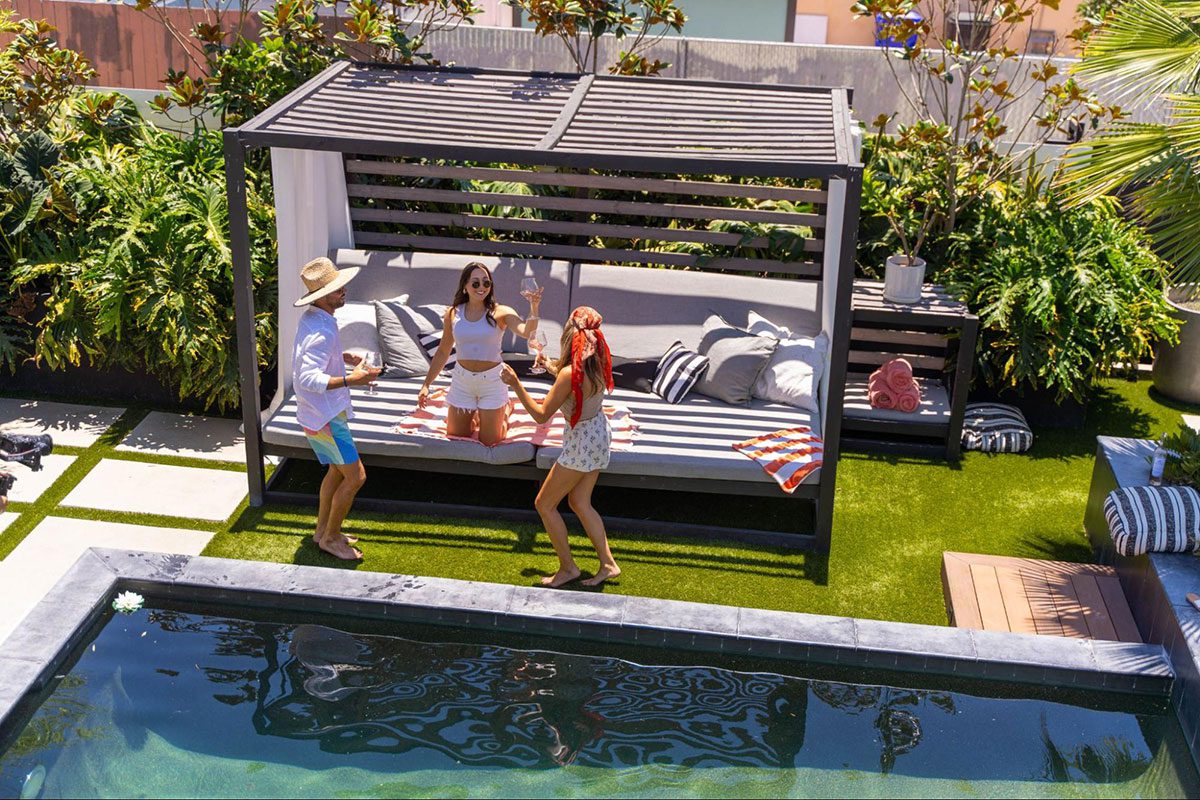Artificial turf uses are numerous, and for good reason. Whether you are a homeowner looking to enhance your outdoor space or a business owner wanting to create a welcoming environment for your clients, artificial grass is an excellent choice. In this blog post, we will discuss the definition of artificial turf, its various applications and benefits, and answer some frequently asked questions to help you decide if artificial grass is the right choice for you.
Definition of artificial turf
Artificial turf is a surface made of synthetic fibers that mimic the look and feel of natural grass. It is often used as a substitute for natural grass in residential and commercial applications due to its durability, low maintenance, and water-saving properties. Artificial turf is also known as synthetic grass, fake grass, or astro turf.
Why use artificial turf over natural grass?
Artificial turf has many benefits over natural grass, making it an excellent choice for residential and commercial applications. For starters, it requires very little maintenance compared to natural grass. It does not need to be mowed, watered, or fertilized, which can save you time and money in the long run. Additionally, artificial turf is highly durable and can withstand heavy foot traffic, making it an ideal choice for high-traffic areas.
Another reason why artificial turf is a popular choice is that it is eco-friendly. It does not require any harmful chemicals, such as pesticides or fertilizers, to maintain its appearance. This means that it is safe for pets and children to play on without any risk of exposure to harmful chemicals.
Where can you use artificial grass?

Artificial grass can be used in a variety of spaces and settings, including balconies, driveways, walls, furniture, home offices, events, pool decks, uneven land, outdoor living and entertaining areas, and rooftop gardens. It is a low-maintenance and attractive alternative to traditional grass that can provide a slip-resistant and safe surface for playing and walking. Artificial grass is also non-toxic and pest-free, making it a safer and more comfortable option for pets to play and relax on. Additionally, artificial grass can save money over time since it doesn’t require regular maintenance or watering like traditional grass does. Here is a brief overview of some of the most popular applications and their benefits:
For pets
For pet owners, artificial grass is a game-changer. Traditional grass can harbor pests like fleas and ticks, as well as toxic chemicals like herbicides and fertilizers, which can be harmful to pets. On the other hand, artificial grass is non-toxic and pest-free, making it a safer and more comfortable option for pets to play and relax on.
For playgrounds
Artificial turf can be a great option for playgrounds due to its durability and safety features. Unlike traditional grass, which can become worn down and patchy over time, artificial turf provides a consistent and stable surface for children to play on. It is also slip-resistant, which can help reduce the risk of slips and falls, and it can be installed with additional padding to provide an even safer surface. Additionally, artificial turf is non-toxic and free of harmful chemicals, making it a safer option for children and the environment. With a variety of colors and styles available, artificial turf can also add a fun and playful touch to any playground design.
For landscaping
Artificial grass offers a lush, green appearance year-round without the need for regular watering, mowing, or fertilizing. This can save homeowners time, money, and effort compared to traditional grass. Additionally, artificial turf is durable and can withstand heavy foot traffic, making it a great option for high-traffic areas such as pathways or outdoor living spaces. It can also be customized to fit any landscape design, from small backyard gardens to expansive public parks. Overall, artificial turf provides an attractive and practical landscaping solution for those looking for a low-maintenance alternative to traditional grass.
For putting greens
First and foremost, it provides a consistent surface for golfers to practice their putts, ensuring that each putt is accurate and true. Unlike natural grass, which can have varying slopes and bumps, artificial turf allows golfers to hone their skills and improve their game. Additionally, artificial turf requires very little maintenance, which means you can spend more time practicing your putting and less time worrying about upkeep. Finally, artificial turf is highly durable and can withstand heavy foot traffic and constant use, making it an excellent choice for golf enthusiasts who want to practice their putting at home.
For indoor home gyms
Artificial turf can be a great option for indoor home gyms because it provides a durable and shock-absorbing surface that can withstand high-impact activities such as weightlifting and cardio workouts. It also offers a non-slip surface that can help prevent injuries from slips and falls. Additionally, artificial turf is easy to clean and maintain, making it a low-maintenance option for home gym owners. Its realistic grass-like appearance can also add a touch of nature to an indoor space, creating a more inviting and calming workout environment. Overall, artificial turf can be an excellent investment for anyone looking to create a safe and functional workout space in their home.
For backyard sports
Unlike natural grass, it doesn’t require regular watering, mowing, or fertilization, making it a more cost-effective and time-efficient option. Additionally, it provides a consistent playing surface that won’t wear down or become uneven over time, which can reduce the risk of injury. The synthetic fibers of artificial turf also offer better traction and shock absorption, which can help prevent slips and falls during intense sports activities. Plus, it can be customized to fit the specific dimensions of your backyard, providing a dedicated playing area for sports like soccer, football, or baseball.
For walkways
Artificial turf is an excellent choice for walkways because it provides a low-maintenance solution that can save you time and money in the long run. Traditional walkways made of concrete or stone can crack or become uneven over time, creating tripping hazards and requiring costly repairs. Artificial turf, on the other hand, provides a smooth and even surface that is slip-resistant and requires little to no maintenance. Additionally, artificial turf is available in a variety of colors and textures, allowing you to customize the look of your walkway to match your aesthetic preferences. Whether you’re looking to create a safe and attractive path in your backyard or a commercial space, artificial turf can provide a practical and visually appealing option.
For roof decks
Artificial turf can be a great option for a rooftop deck due to its low maintenance and durability. Traditional grass can be difficult to grow in rooftop environments due to lack of sunlight and limited drainage, making it an impractical option. On the other hand, artificial turf is specifically designed to withstand harsh weather conditions and heavy foot traffic, making it ideal for rooftop decks. It also provides a comfortable and attractive surface for lounging and entertaining, while adding a touch of greenery to an urban environment. Furthermore, artificial turf doesn’t require watering, mowing or fertilizing, making it a cost-effective and eco-friendly option for rooftop decks.
For pool decks
Artificial grass is an excellent option for pool decks. It provides a comfortable and slip-resistant surface that is ideal for wet environments. Natural grass can easily become slippery when wet, which can be dangerous for swimmers. However, artificial grass is made of materials that are designed to remain slip-resistant even when wet, making it an excellent choice for pool decks. Additionally, artificial grass is easy to maintain and does not require the same level of care as natural grass. This makes it an attractive option for homeowners who want a lush, green look around their pool without the maintenance that natural grass requires.
For outdoor living and entertaining areas
Artificial grass is a great option for outdoor living and entertaining areas. It provides a lush, green look that can create a welcoming atmosphere for family and friends. It’s also soft to the touch, making it a comfortable surface to walk or sit on. Unlike natural grass, artificial grass doesn’t require watering, mowing, or fertilizing, which makes it an easy-to-maintain option. It’s also resistant to pests and weeds, which means it will continue to look great all year round. Additionally, artificial grass can be used to cover up unsightly concrete or pavement, transforming a dull area into a beautiful, inviting space.
For uneven land
Artificial grass is a great solution for uneven land. It can be easily installed on slopes, hills, and other uneven surfaces. Unlike natural grass, which can be difficult to grow and maintain on uneven terrain, artificial grass is versatile and can be cut to fit the contours of the ground. This makes it an ideal option for homeowners who have uneven areas in their yards that they want to cover with a lush, green surface. Additionally, artificial grass doesn’t require the same level of care as natural grass, which can make it an attractive option for those who want a low-maintenance yard.
For home offices
Artificial grass can be a great addition to home offices, providing a calming and relaxing environment that can increase productivity and reduce stress levels. It can be used to create a soft and inviting floor covering or to add a touch of greenery to your workspace. This can help to create a more natural and calming atmosphere in your home office, which can lead to increased focus and creativity. Additionally, artificial grass is easy to maintain and doesn’t require the same level of care as natural grass. This makes it a practical choice for those who want to create a beautiful and natural-looking workspace without the hassle of traditional gardening.
Where you can install artificial turf:
- Playgrounds
- Lawns and landscaping
- Indoor and outdoor sports
- Gym flooring
- Around pool decks
- For dogs and other pets
- Putting greens
Benefits of placement for artificial grass
Saves money and good for environment
One of the most significant benefits of using artificial grass is that it can save you money over time. Traditional grass requires regular maintenance and watering, which can add up in terms of cost. With artificial grass, however, you don’t need to worry about watering, mowing, or fertilizing, which can help you save on both water and maintenance costs. Additionally, since artificial grass doesn’t require pesticides or other chemicals to maintain, it can be a more environmentally friendly option.
Pet safety
For pet owners, artificial grass is a game-changer. Traditional grass can harbor pests like fleas and ticks, as well as toxic chemicals like herbicides and fertilizers, which can be harmful to pets. On the other hand, artificial grass is non-toxic and pest-free, making it a safer and more comfortable option for pets to play and relax on.
Human safety
If you have children or are concerned about safety around your pool or outdoor living area, artificial grass can provide a slip-resistant and safe surface for playing and walking. Unlike traditional grass, which can become slippery when wet, artificial grass provides a stable surface that can help reduce the risk of slips and falls.
What to know about using artificial grass
Artificial grass is a versatile option for a variety of uses. It can be used to cover balconies, providing an easy-to-maintain alternative to concrete or tile. It may also be used to cover furniture, creating unique seating areas or soft play areas for children. For those who work from home, artificial grass can be used to create a calming and relaxing environment in a home office. Artificial grass is often used at events, providing an attractive backdrop or comfortable seating areas for guests. Additionally, it can be used in rooftop gardens, providing a low-maintenance and attractive surface for plants. While it’s possible to use artificial grass to cover driveways, it may not be as durable as other materials and may not be suitable for high-traffic areas. Overall, artificial grass is a versatile option that can add a touch of greenery and comfort to a variety of spaces.
Frequently asked questions
What surfaces can you lay artificial grass on?
Artificial grass can be installed on a variety of surfaces, including soil, concrete, asphalt, and decking. However, it’s important to note that the quality of the installation and the lifespan of the artificial grass will vary depending on the surface it’s installed on.
When installing artificial grass on soil, it’s important to properly prepare the surface by removing any rocks or debris and compacting the soil. This will ensure that the surface is level and stable, which will help prevent any unevenness or sinking over time.
For concrete and asphalt surfaces, the artificial grass can be glued directly onto the surface or laid over a layer of foam padding to provide cushioning and improve drainage. When installing it on decking, it’s important to use a breathable underlay to allow for proper drainage and prevent the growth of mold or mildew.
What is the downside to using artificial grass?
While there are many benefits to using artificial grass, there are also some potential downsides to consider. One of the main drawbacks is that artificial grass can be more expensive than natural grass, especially when it comes to the initial installation cost. Additionally, artificial grass may not be as environmentally friendly as natural grass, as it is typically made from synthetic materials that are not biodegradable.
Another potential downside of artificial grass is that it may not have the same aesthetic appeal as natural grass. While high-quality artificial grass can look very realistic, some people may prefer the look and feel of natural grass.
Finally, it’s important to consider the maintenance requirements of artificial grass. While it may require less maintenance overall than natural grass, it still needs to be regularly cleaned and brushed to maintain its appearance and prevent the buildup of debris and dirt.
How do I choose between different artificial grass products?
When choosing between different artificial grass products, there are several factors to consider. First, consider the intended use of the artificial grass, as some products may be better suited for certain applications than others.
You’ll also want to consider the quality and durability of the artificial grass, as well as its appearance and feel. Look for products that have a high stitch rate and density, as well as a soft and realistic texture. It’s also important to choose a product that is UV-resistant and has good drainage capabilities.
Finally, consider the price and any warranty or guarantee offered by the manufacturer. While it may be tempting to go with the cheapest option, it’s important to invest in a high-quality product that will last for many years to come.
How hot can artificial grass get?
Artificial grass can get quite hot in direct sunlight, especially during the summer months. However, the actual temperature will depend on a variety of factors, including the color of the artificial grass, the location of the installation, and the ambient temperature and humidity.
To minimize heat buildup, it’s important to choose a light-colored artificial grass that reflects more of the sun’s rays. You can also consider installing a sprinkler system or misting fans to cool the area around the artificial grass.
Overall, while artificial grass can get hot, it is still a safe and durable option for a variety of applications. With proper installation and maintenance, artificial grass can provide a beautiful and low-maintenance alternative to natural grass.
Related resources:
- Where you can use artificial grass
- Cost of artificial grass
- How to choose the best artificial grass
- How to clean artificial grass
- Water bill savings with artificial grass
- How long does artificial turf last?
- Artificial turf supplies
- Artificial grass vs real grass
- Pros and cons of artificial grass
- Artificial grass installation guide
- Does artificial grass fade?
- Does artificial grass need water?
- How to install artificial turf



